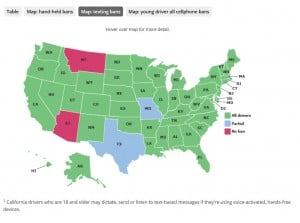 Six national organizations are pushing for changes in transportation safety programs in the next reauthorization bill to provide additional funding to states that pass tougher traffic safety laws.
Six national organizations are pushing for changes in transportation safety programs in the next reauthorization bill to provide additional funding to states that pass tougher traffic safety laws.
AAA, Advocates for Highway and Auto Safety, Governors Highway Safety Association, Mothers Against Drunk Driving, the National Safety Council and Safe Kids Worldwide have developed improvements to the grant qualification criteria aimed to encourage more states to enact optimal laws that reduce impaired driving, distracted driving and teen driving-related crashes.
The group urges the Senate Commerce, Science and Transportation Committee and House Transportation and Infrastructure Committee to adopt recommended changes, which were developed after careful analysis of current regulations, laws and data that have proven to save lives. These modifications should provide meaningful incentives that will more effectively encourage state legislatures to act, leading to the passage of strong laws which will make roads and highways safer for all motorists.
Some of recommendations from the organizations are:
All-Driver Texting Ban – Must have all of the following:
- State statute must prohibit all drivers from texting while driving.
- State statute must explicitly prohibit reading or manually entering data into a personal wireless communications device.
- State statute must not have an explicit exception that allows for texting while stopped in traffic.
- State statute must make a violation of the texting ban a primary offense.
- State statute must provide for a minimum fine for all violations. Minimum fine amount to be determined by NHTSA rulemaking.
Youth Cell Phone Use Prohibition – Must have all of the following:
State statute must prohibit one of the following groups from using a personal wireless communications device while driving.
- Novice drivers in the learner’s permit and intermediate license stages.
- Drivers under the age of 18.
- State statute must not have an explicit exception that allows drivers covered by youth cell phone use prohibition to use a wireless communication device while stopped in traffic.
- State statute must make violation of the youth cell phone use prohibition a primary offense.
- State statute must provide for a minimum fine for all violations. Minimum fine amount to be determined by NHTSA rulemaking.
Distracted Driving Issue Testing
- States must test for distracted driving issues as part of the driver’s license examination process.States that test for distracted driving issues administratively are not required to have testing requirements codified in statute.
- Exceptions: Any of the following exceptions should not prohibit a state from qualifying for the incentive grant:
- Drivers who use a personal wireless communications device to contact emergency services.
- Emergency services personnel who use a personal wireless communications device while operating an emergency services vehicle and engaged in the performance of their duties as emergency services personnel.
- Individuals employed as a commercial motor vehicle driver or a school bus driver who uses a personal wireless communications device within the scope of such individual’s employment if such use is permitted under federal regulations Any additional exceptions determined by NHTSA in the rulemaking process that implements the incentive grant.
Additional Provision
NHTSA shall issue a study on distracted driving. Study to identify the legal and technical barriers to capturing data on the prevalence of wireless communications devices while driving and provide recommendations on how to address such barriers.
The group applauds the leadership of these Committees for establishing the incentive grant programs in the 2012 Moving Ahead for Progress in the 21st Century Act (MAP-21) (Pub. L. 112-141). However, several of the qualification provisions coupled with the National Highway Traffic Safety Administration’s (NHTSA) interpretations of qualification criteria have limited the number of states receiving incentive grant funding.
Under the current grant criteria, only a handful of states qualified for these incentive grants in the current fiscal year. By clarifying some of the provisions and including some specific changes, states that enact the most critical traffic safety improvements should be able to qualify for the funding they need to effect real and sustained change.
More than 35,000 people are needlessly killed each year in car crashes. According to preliminary NSC estimates, fatalities are 11 percent higher this year than they were during the same period in 2014. It will take coordinated efforts and leadership by our elected officials to reduce these deaths.